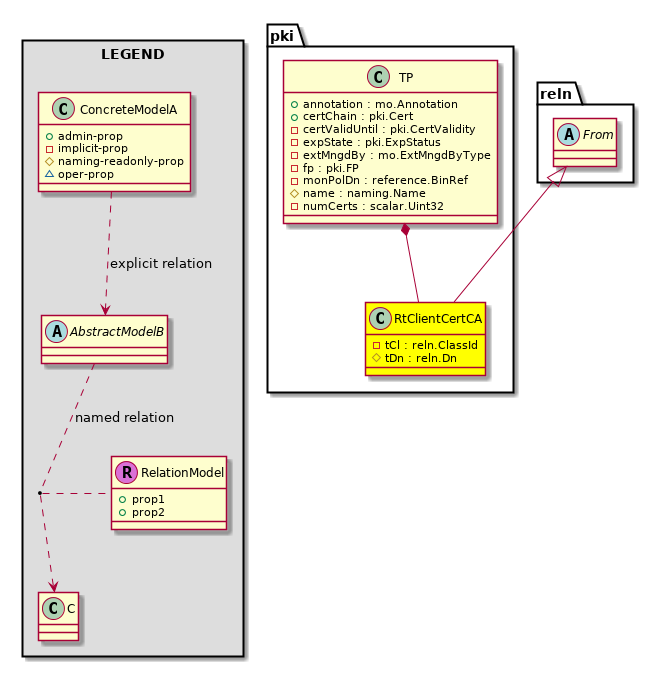![[V]](styles/eye.gif) |
top:Root This class represents the root element in the object hierarchy.
All managed objects in the system are descendants of the Root element. |
|
|
|
|
|
├
|
![[V]](styles/eye.gif) |
pol:Uni Represents policy definition/resolution universe. |
|
|
|
|
|
|
├
|
![[V]](styles/eye.gif) |
fv:Tenant A policy owner in the virtual fabric. A tenant can be either a private or a shared entity. For example, you can create a tenant with contexts and bridge domains shared by other tenants. A shared type of tenant is typically named common, default, or infra. |
|
|
|
|
|
|
|
|
├
|
![[V]](styles/eye.gif) |
pki:TP A trustpoint (certificate authority/CA), which issues and validates (signs) digital certificates. When participating in secure communications using the public key infrastructure (PKI), a participant can verify the identity of the other party through the CA that signed the other party's public key. |
|
|
|
|
|
|
|
|
|
├
|
![[V]](styles/eye.gif) |
pki:RtClientCertCA |
![[V]](styles/eye.gif) |
top:Root This class represents the root element in the object hierarchy.
All managed objects in the system are descendants of the Root element. |
├
|
![[V]](styles/eye.gif) |
pol:Uni Represents policy definition/resolution universe. |
|
├
|
![[V]](styles/eye.gif) |
fv:Tenant A policy owner in the virtual fabric. A tenant can be either a private or a shared entity. For example, you can create a tenant with contexts and bridge domains shared by other tenants. A shared type of tenant is typically named common, default, or infra. |
|
|
|
├
|
![[V]](styles/eye.gif) |
pki:TP A trustpoint (certificate authority/CA), which issues and validates (signs) digital certificates. When participating in secure communications using the public key infrastructure (PKI), a participant can verify the identity of the other party through the CA that signed the other party's public key. |
|
|
|
|
├
|
![[V]](styles/eye.gif) |
pki:RtClientCertCA |
![[V]](styles/eye.gif) |
top:Root This class represents the root element in the object hierarchy.
All managed objects in the system are descendants of the Root element. |
|
|
|
|
|
├
|
![[V]](styles/eye.gif) |
pol:Uni Represents policy definition/resolution universe. |
|
|
|
|
|
|
├
|
![[V]](styles/eye.gif) |
aaa:UserEp A user endpoint is a local user. A user is assigned a role determines the user's privileges, and belongs to a security domain, which determines the user's scope of control |
|
|
|
|
|
|
|
├
|
![[V]](styles/eye.gif) |
pki:Ep The PKI configuration, which includes key rings and certificate authority (CA) credentials. Components of the PKI are used to establish secure communications between two devices. |
|
|
|
|
|
|
|
|
├
|
![[V]](styles/eye.gif) |
pki:TP A trustpoint (certificate authority/CA), which issues and validates (signs) digital certificates. When participating in secure communications using the public key infrastructure (PKI), a participant can verify the identity of the other party through the CA that signed the other party's public key. |
|
|
|
|
|
|
|
|
|
├
|
![[V]](styles/eye.gif) |
pki:RtClientCertCA |
![[V]](styles/eye.gif) |
top:Root This class represents the root element in the object hierarchy.
All managed objects in the system are descendants of the Root element. |
├
|
![[V]](styles/eye.gif) |
pol:Uni Represents policy definition/resolution universe. |
|
├
|
![[V]](styles/eye.gif) |
aaa:UserEp A user endpoint is a local user. A user is assigned a role determines the user's privileges, and belongs to a security domain, which determines the user's scope of control |
|
|
├
|
![[V]](styles/eye.gif) |
pki:Ep The PKI configuration, which includes key rings and certificate authority (CA) credentials. Components of the PKI are used to establish secure communications between two devices. |
|
|
|
├
|
![[V]](styles/eye.gif) |
pki:TP A trustpoint (certificate authority/CA), which issues and validates (signs) digital certificates. When participating in secure communications using the public key infrastructure (PKI), a participant can verify the identity of the other party through the CA that signed the other party's public key. |
|
|
|
|
├
|
![[V]](styles/eye.gif) |
pki:RtClientCertCA |
|

